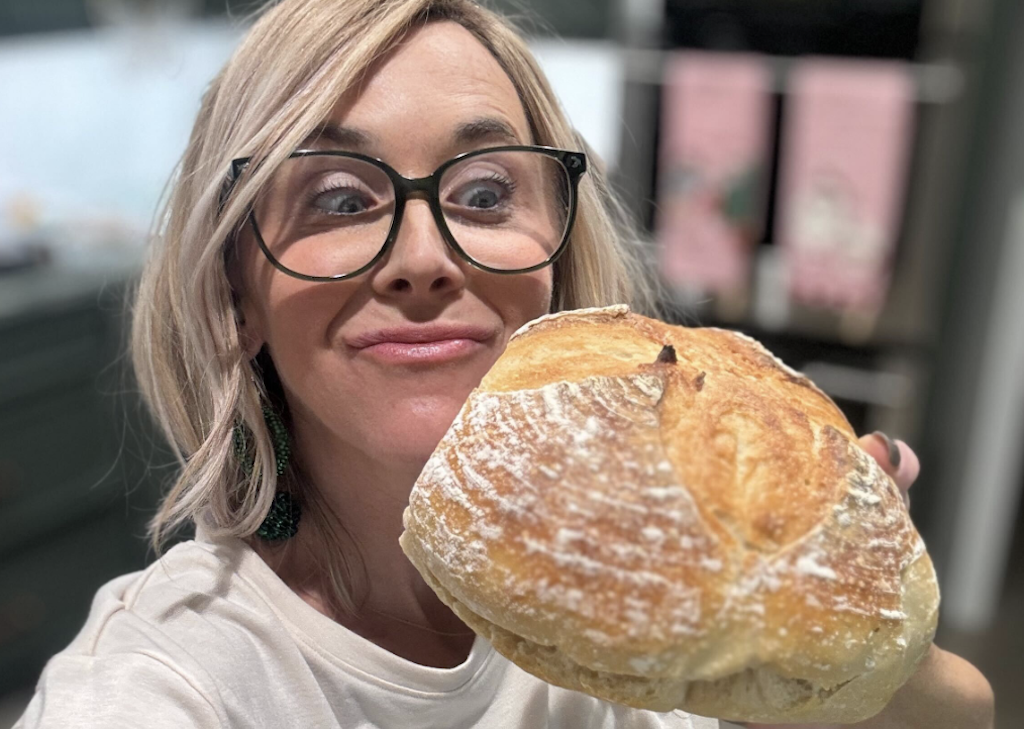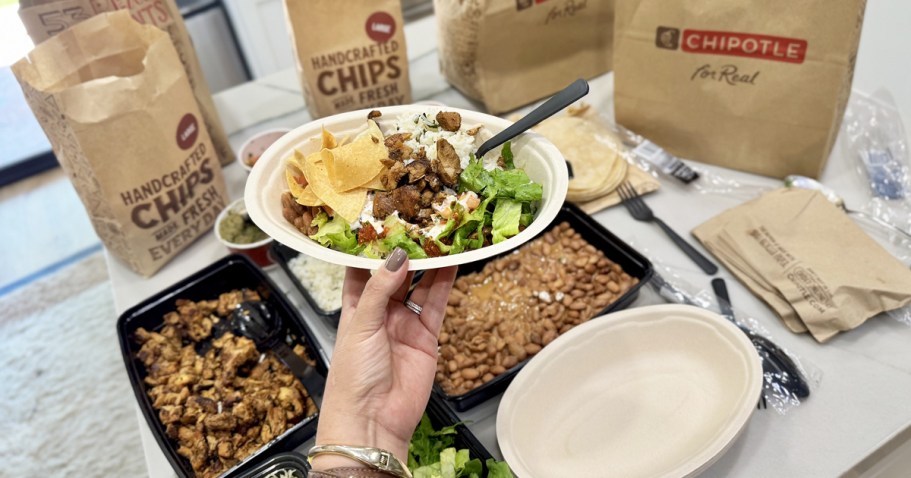Here’s How to Make Sourdough Bread (It’s Easier Than You Think!)
This year, learn how to make sourdough bread using our beginner guide.

Let’s bake some delicious sourdough bread!
Today, I’m sharing how to make a beautiful, chewy, crusty sourdough loaf your family will love! With these simple tips, you’ll see how easy (and addicting!) it can be. Once you get the timing and method down, you’ll feel like a sourdough pro!
All you need is water, flour, and salt—just 3 ingredients from starter to finished loaf. I’ll also share my favorite kitchen tools to make the process easier.
I’ve had my fair share of sourdough fails (especially same-day recipes), but this method is foolproof! Trust me, the flavor and that crispy crust make it so worth the time!

Sourdough baking is easy once you get the timing down!
I prefer the sourdough loaf method where you mix the dough at night, let it rise on the counter, then come back the next day to shape and bake it, which is the process shared by Emilie Raffe. I started with her everyday sourdough recipe and now after having made sourdough bread probably 50 times, I’ve modified it slightly (see below.) Her book Artisan Sourdough Made Simple by Emilie Raffe is also a really great resource – highly recommend it!
Baking Timeline Example:
- 11am-1pm – feed sourdough starter
- 9:00 pm – mix dough
- 9:30 pm – work dough (stretch and folds)
–let rise overnight– - 9:30 am – shape dough and 2nd rise
- 10:30 am – score and bake
- 12:30 pm – slice and enjoy or save for dinner
Easy Sourdough Loaf
yield: 10 SERVINGS
cook time: 55 MINUTES
total time: 55 MINUTES
Learn to bake a simple sourdough boule or round loaf with an overnight fermentation.
Ingredients
- 60 grams (1/4 cup) active sourdough starter
- 350 grams (1 1/3 cups + 2 tbsp) room temperature water
- 500g (4 cups + 2 tbsp) bread flour
- 10 grams (2 teaspoons) fine sea salt
Directions
1
In the evening whisk the dough together by combining the starter and water first in a mixing bowl. Then add in the flour and salt. Use the Danish whisk at first and then go in with clean hands until a dough is formed. It will be sticky. Cover with a towel and let rest for 30 minutes.
2
Come back and use a dough scraper to form the dough into a ball in the bowl. Stretch and fold the dough by pulling up and then folding it back into the middle and turning bowl. Do a couple of these to create elasticity and strengthen the dough.
3
Cover the bowl with a damp kitchen towel or bowl cover overnight on the counter for about 10-12 hours until the dough gets puffy and doubles in size.
4
In the morning, gently scrape the dough out of the bowl onto a lightly floured surface. Shape it into a round ball, and place into a banetton basket or towel lined bowl. Cover for an additional 30-60 minutes until puffy but not quite doubled in size.
5
Preheat the oven to 450 degrees. Place the dough onto a dough sling or parchment paper and into a Dutch oven. Bake for 20 minutes with the lid on. Remove the lid and bake for another 25-30 minutes until browned and the internal temp is between 204-10 degrees. Let the bread cool on a cooling rack for at least an hour before cutting.
Additional Notes
Recipe adapted from Emilie's Everyday Sourdough.
Here’s a detailed rundown of the steps to make a sourdough loaf:

1. First things first, grab or make your sourdough starter!
To make this bread, you need a sourdough starter instead of yeast. You can get an active starter from a friend, grow your own in about a week, or buy a fresh sourdough starter online.
Here’s how to grow your own sourdough starter:
Day 1: Mix 1/4 cup (60 grams) water and 1/2 cup (60 grams) flour in a jar with a lid, on the counter.
Day 2: Let it rest.
Days 3–7: Each day, discard all but 1/4 cup of the mixture, then add 1/4 cup water and 1/2 cup flour.
Repeat until the starter is bubbly, active, and doubles in size each feed.
This method uses a 1:1:1 ratio of flour, water, and starter, and works well with all-purpose flour such as Gold Metal.

How to feed sourdough starter:
- Every day, discard a portion of the starter and feed it water & all-purpose flour.
- I use 1/4 cup of starter (discard the rest) then add 1/4 cup water & 1/2 cup flour. It will be very thick.
- Once your starter is active, if you are not baking right away, you can store it in the fridge, then start feeding it again to “wake” it up and use later. Typically you can store it in an airtight jar for 2 weeks in the fridge, up to a month, and have it be fine. Some people do even longer. It’s suggested to dehydrate your starter and freeze it in an airtight bag beyond that.
TIP – Save your sourdough discard after the first week. Most people keep a container of discard in the fridge and you can make wonderful things like fluffy pancakes, banana bread, crackers, cookies, and tortillas to name a few. There are so many yummy options!
Discard can last for up to a month or so covered with a tight lid in the fridge. Beyond that, it will start to taste sour and acidic.
2. Mix up your dough before bedtime.

- In a mixing bowl, incorporate the active sourdough starter, room-temperature water, bread flour, and fine salt.
- I use a dough whisk at first to mix and then go in clean hands to combine. Your dough will be quite sticky and shaggy at first.
- Cover it with a towel and let it rest for 15-30 minutes.
I typically use King Arthur unbleached bread flour, but I also love Bob’s Redmill Artisan Flour. It’s pricier, but it makes a soft yummy dough. Bryn, my Hip Sidekick, loves Kirkland brand all-purpose flour from Costco as it has a higher protein level. It’s fun to test different brands to find your favorite!

- Use a dough scraper to scrape the sides of the bowl and form the dough into a ball.
- Stretch and fold the dough a few times with your hands, doing it right in the bowl. This helps make the dough firmer and more elastic, which improves the rise.
Do you need a kitchen scale? No, but it’s much easier and more accurate to weigh ingredients. Using a scale gives you more consistent results.
3. Bulk fermentation takes place overnight.
- Cover your mixing bowl with a damp kitchen towel, lid, or reusable bowl wrap.
- Let this sit for about 8-10 hours overnight. You are looking for the dough to double in size.
4. In the morning, it’s time to shape and 2nd rise.



- Use a dough scraper to gently transfer the dough from the bowl to a lightly floured surface.
- Shape the dough into a round loaf. Try to fold the dough underneath while turning it with your hand or dough cutter.
- Place the ball into a banneton-proofing basket or towel-lined bowl.
- Cover and let rise again for about 30 minutes to an hour. It should look puffy but not quite doubled in size.
5. Now it’s time to score and bake your bread!

- Transfer the dough to a silicone bread sling or piece of parchment paper.
- Place the sling & dough inside a cast iron Dutch oven with lid.
- Use a knife or dough scoring tool to make an x shape on top of the loaf.

- Bake at 450 degrees with the lid on for 20 minutes.
- Remove the lid and bake for another 25-30 minutes until browned and the internal temp is between 204-10 degrees.
- Let the bread cool on a cooling rack for at least an hour before cutting.
Baking Tip: Try placing a large sheet pan in the bottom rack during baking to prevent the bottom of the bread from browning too much.
To store sourdough bread:
For the short term, leave it on the counter, loosely wrapped in a paper bag so it can breathe. You can use a plastic bag, but it might get a little soggy. For long-term storage, slice the bread and freeze it. It’s perfect for toasting!
Curious to know what baking tools I like use?

Here are some of my favorite sourdough baking supplies:
- Mainstays Cast Iron 4.5-Quart Dutch Oven – I own 2 as they can both fit in my oven at once to make two loaves! They are such great quality for the price!
- Sourdough Silicone Bread Slings – Save on parchment paper and buy these instead! They make it so easy to get your bread out of the Dutch oven.
- Kitchen Baking Scale – One thing about sourdough is that it’s important to get the measurements correct. This inexpensive scale is easy to use and compact!
- Instant Read Thermometer – The easiest way to know your dough is cooked is by using a thermometer to make sure it has reached the internal temperature of 205-210 degrees.
- Banneton Bread Proofing Baskets with Accessories – These baskets are so handy for the final proofing stage, fold flat for storage, and come with all the kitchen tools needed like a blade for scoring and a dough whisk.
- Sourdough Starter Kit with Jar – You can of course use any glass jar. I like the larger size and flat sides that make stirring easier. Plus the spatula that comes with is nice an the lid is breathable.
- Bench Scrapers – You can never have too many of these helpful tools to scrape the dough from the sides of a bowl. It makes sourdough life easier!
- Paper Bags for Storing & Gifting – Baking and giving away bread is extremely thoughtful and rewarding. Consider using these bags for convenient gifting.
- Reusable Bowl Covers – Instead of using kitchen towels or plastic wrap on bowls during fermentation, I opt for these bowl covers! They are eco-friendly and work well. My dough doesn’t dry out at all.
You can even bake this sourdough bread in a bundt pan!

I have baked my sourdough a couple of times now inside this 12 cup bundt pan using the same dough recipe and it has turned out great!
Follow these easy steps to bake in a bundt pan:
- After the first rise, shape the dough into a ball and poke your finger through the middle. Place it inside a greased bundt pan.
- Cover the pan with a towel and let it go through a 2nd rise for about 20-30 minutes. Score the top.
- Cover the pan with a cast iron lid and bake in the oven at 450 degrees for 20 minutes.
- Remove the lid and bake for an additional 15 minutes or until cooked through.
It does bake a little faster than the traditional sourdough boule shape, so watch that it doesn’t burn. It was also easier to slice up, and a fun experiment!

I am still fairly new to sourdough baking and LOVE IT!
This is the most fun and satisfying hobby. There really isn’t too much hands-on time so I like that it’s fairly easy and doable. Plus there’s only water, flour and salt in this recipe. What delclious homemade natural bread. The sour taste is my favorite!

Benefits of sourdough bread:
- Easier to digest: The sourdough starter fermentation process breaks down carbs, making it gentler on your stomach and better for overall gut health.
- Lower glycemic index: It’s better for controlling blood sugar.
- Better for gluten sensitivity: Some people find it easier to tolerate than other breads.
- Fewer preservatives: It’s a natural, preservative-free option and tastes great!

I would encourage anyone to give this a try. If I can do it you can too! You don’t need any experience baking bread to come away with a delicious loaf. There are a zillion methods and recipes online for sourdough and this is what has worked best for me. I wish you all the sourdough success too!
Loving Lina’s marbled covered butter dish in the photo? You can snag it here!
Check out all our amazing easy and delicious soup recipes to pair with this bread!





Thanks Lina! I’m going to start this weekend making my starter! Can’t wait for fresh bread!
Yay!! I am so happy! You are gonna love it.
There are many sourdough group on Facebook and instagram. People usually don’t mind sharing, just ask.
You can start baking faster.
Thanks Jurga! I agree. I actually bought a sourdough starter once from facebook marketplace. It was a woman in my neighborhood and she was so helpful too!
Thank u for all the info. Can you please send a link for the Dutch oven. Thank you
You’re welcome, Cindy! Here’s the link to the dutch oven Lina is using if helpful! 💖
The sling has a max temp of 430 degrees. Should we bake the dough at that temp for a longer time?
Hi Samantha! I am seeing 446 listed as max temp. Hmm… regardless I have never had an issue baking at 450 but yes you could lower it a bit, use parchment, or some people even grease with oil. I have not tried that yet. Just check the internal temp and you would be good to go! Hope that helps 🙂
what is the brand of your scraper chopper blade with the wooden handle and what size is it?
Hi LaNette! The scraper is included in this set from Amazon if helpful! 💗
I want to try this so bad! Thanks for all the tips and the links to products you use. Question if you use the bowl covers instead of the kitchen towel do you need to wet the bowl covers? – thanks
No need to wet the bowl covers. I live in a dry climate so they work better for me as they have a plastic lining. You can also use plastic wrap or a cheap shower cap works too!
Thank you!
If it’s 1:1;1 ratio why does it say to feed starter 1/4 cup starter 1/4 cup water and 1/2 cup flour
Apologies for any confusion, Kim! 🤗 These are equal parts by weight, but each cup measurement is by volume. Hope that helps! ❤️
What size Banneton baskets do you use for your DO?
Hi there! It is a 10 inch basket, linked above! 💕🤗
I’ve been using a baking stone and open baking. I wish I could share a picture. I like the bread a whole lot better than in a Dutch oven. By the way, your bread looks wonderful!
Thanks for the sweet comment and for sharing how you’ve been baking yours, Carol! 💖
If you don’t do what I’m about to tell you you’re missing out 😂
On the last shaping before bulk fermenting , (or at any of the shape and folds) add 4 tablespoons of frozen shredded butter!!!
You will not regret it!
You get a croissant loaf and it’s amazing!🤩